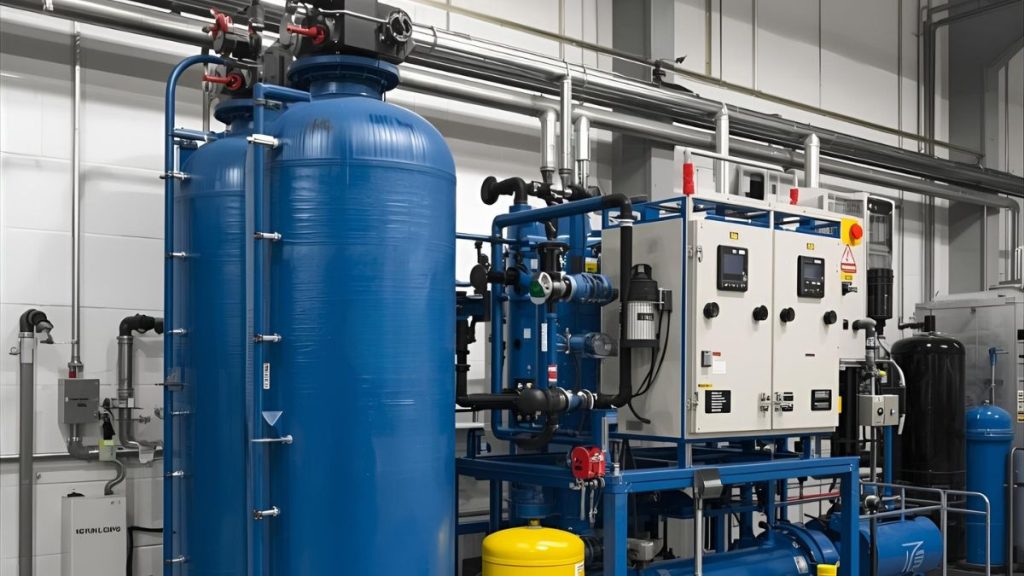Ion exchange systems are one of the most reliable technologies in water treatment, particularly for removing unwanted ions, such as calcium and magnesium, as well as various other dissolved contaminants. This technology is widely used in various industries, including power generation, drinking water treatment, and pharmaceutical applications.
However, while these systems have proven effective, various problems can arise over time, affecting their performance and efficiency. Understanding common ion exchange system problems and how to address them is key to maintaining the quality of the produced water and ensuring a longer equipment lifespan.
Common Ion Exchange System Problems
Here are some common ion exchange system problems to watch out for, along with their causes, impacts, and solutions.
1. Resin Fouling
Resin fouling is one of the most common problems encountered in ion exchange systems. Fouling occurs when the resin becomes clogged or coated with organic particles, oil, heavy metals, or colloids present in the raw water. The accumulation of these contaminants can reduce the ion exchange capacity and increase the differential pressure in the column.
Impact
- Decreased ion exchange efficiency.
- Increased regeneration requirements, which means higher operational costs.
- Decreased treated water quality.
Solution
- Good initial filtration: Use a pre-filter such as a multimedia filter or activated carbon filter to reduce the particle and organic load before the water enters the ion exchange system.
- Regular resin cleaning: Use a suitable resin cleaner to remove impurities and extend the resin’s lifespan.
- Raw water quality monitoring: Conduct regular tests for TSS (Total Suspended Solids), iron, manganese, and dissolved organic matter.
Read Also: Resin Fouling: Causes, Impacts, and How to Prevent It in Ion Exchange Systems
2. Resin Oxidation
Resin oxidation is usually caused by prolonged exposure to strong oxidizers such as free chlorine or ozone. These chemicals can damage the resin polymer structure, resulting in permanent damage.
Impact
- Resin becomes brittle and easily broken.
- Decreased ion exchange capacity.
- Leakage of resin particles into the water stream.
Solution
- Dechlorination before entering the system: Use an activated carbon filter or sodium bisulfite dosing to remove free chlorine from the raw water.
- Disinfectant Dosage Control: Ensure the oxidizer dosage meets standards to prevent resin damage.
- Replacement of Damaged Resin: If damage is severe, the resin must be completely replaced to restore system performance.
3. Thermal Resin Degradation
Thermal degradation occurs when the resin is exposed to excessively high water temperatures, typically above 60–70°C for standard cation exchange resins. High temperatures can cause physical damage to the resin beads and alter its chemical properties.
Impact
- The resin loses mechanical strength.
- Ion exchange capacity decreases drastically.
- Ion leakage occurs, which should be eliminated.
Solution
- Raw water temperature regulation: Ensure the water entering the system is within the safe range for the resin being used.
- Use high-temperature resin: For certain industrial applications, use resin formulated to withstand heat.
- Continuous temperature monitoring: Install temperature sensors to prevent sudden heat spikes.
4. Channeling
Channeling occurs when the water flow in the resin column is uneven, usually due to poor flow distribution or suboptimal resin packing. This results in some of the resin being used ineffectively.
Impact
- Ion exchange efficiency decreases.
- Regeneration becomes ineffective.
- Treated water quality becomes inconsistent.
Solution
- Improve flow distribution: Ensure inlet and outlet distributors are functioning optimally.
- Re-packing resin: Rearrange the resin in the column for even distribution.
- Hydraulic testing: Evaluate flow patterns to detect channeling early.
5. Mechanical Resin Damage
Mechanical damage to the resin is usually caused by excessive backwashing, high pressure, or friction between resin particles and mechanical components.
Impact
- Resin particles break into smaller pieces, clogging the downstream system.
- Ion exchange capacity and quality decrease.
Solution
- Proper backwash settings: Follow the resin manufacturer’s guidelines regarding backwash rate and duration.
- System pressure control: Avoid pressure spikes that can damage the resin.
- Periodic inspections: Ensure resin condition visually and through laboratory testing.
6. Biological Fouling
Biological fouling occurs when bacteria or microorganisms grow inside the resin column. This is generally triggered by stagnant water in the system or the introduction of biological contaminants from the raw water.
Impact
- Decreased ion exchange capacity.
- Increased risk of microbiological contamination in the treated water.
- Unpleasant odors in the water.
Solution
- Regular disinfection: Use a controlled dose of chlorine or hydrogen peroxide solution to clean the resin column.
- Contamination source control: Ensure all raw water sources are free of harmful microorganisms.
- Regular water circulation: Avoid stagnant conditions in the column.
Read Also: Why is My Cooling Tower Experiencing Biofouling?
Trust the Performance of Your Ion Exchange System to Lautan Air Indonesia
Addressing common ion exchange system problems requires a comprehensive technical approach, from selecting the right chemicals and system maintenance to responsive technical support.
As a trusted industrial partner for over four decades, Lautan Air Indonesia offers complete solutions for your ion exchange systems, including:
- Provision of high-quality resins and regenerant chemicals
- Resin maintenance and cleaning services
- Control and sensor-based performance monitoring systems
- Technical consultation and system modifications according to process requirements
- Performance Based Contract (PBC)
Ensure your industrial ion exchange systems operate optimally, efficiently, and meet standards. Lautan Air Indonesia is ready to be your best partner in maintaining reliable and cost-effective operations.
Contact our technical team for consultations and field surveys.



